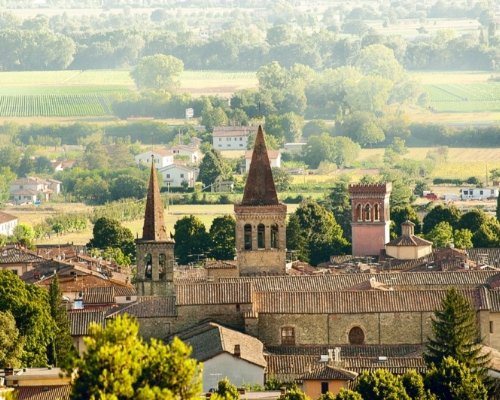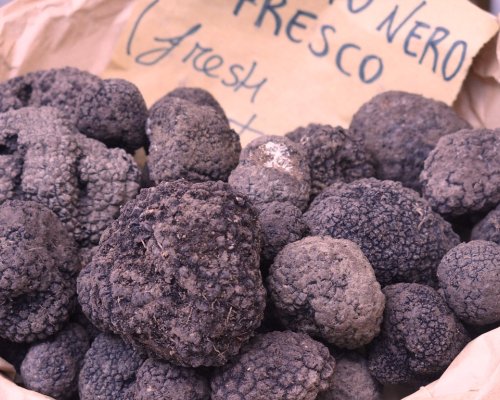


Amidst medieval villages, art and recipes in a unknown corner of Tuscany
Today we are bringing you on a journey through the Tuscan Valtiberina, a territory on the border with Emilia-Romagna, Umbria and Marche. We’re in an area rich in priceless cultural, natural and artistic patrimony still unknown to the masses.
To discover and enjoy the best of what this region has to offer, we recommend you visit the historic villages: Anghiari, Badia Tedalda, Caprese Michelangelo, Monterchi, Pieve Santo Stefano, Sansepolcro and Sestino. It will be a journey to discover their rural traditions and culinary treats.
You can begin in Anghiari, a characteristic medieval village, whose spirit is reflected in the small, winding streets, in the palaces, the churches, the balconies adorned with flowers and the numerous artisan workshops that have worked to keep traditions alive in this territory. The countryside around Anghiari is surrounded by olive groves that produce an excellent oil, bestowed with the flavour of herbs.
The next stop is Monterchi, the home town of Monna Romana, mother of Piero della Francesca, where you can admire the famous fresco Madonna del Parto inside the Civic Museums. The sunflower fields and corn harvesting characterize the intense farming activity and polenta is the village’s typical dish, which is celebrated by the Polenta Sagra every autumn.
You can begin in Anghiari, a characteristic medieval village, whose spirit is reflected in the small, winding streets, in the palaces, the churches, the balconies adorned with flowers and the numerous artisan workshops that have worked to keep traditions alive in this territory. The countryside around Anghiari is surrounded by olive groves that produce an excellent oil, bestowed with the flavour of herbs.
The next stop is Monterchi, the home town of Monna Romana, mother of Piero della Francesca, where you can admire the famous fresco Madonna del Parto inside the Civic Museums. The sunflower fields and corn harvesting characterize the intense farming activity and polenta is the village’s typical dish, which is celebrated by the Polenta Sagra every autumn.
Continuing toward Sansepolcro, you’ll come across cultivated tobacco fields. This is where the prestigious Kentucky Tobacco is grown, which is used to make Toscano cigars. The Toscano Extra Vecchio was created in 1953, when the techniques for making the Toscano cigar were perfected; the cigar is the result of a long Tuscan tradition.
The excellent production of vegetables, fruit, greens and cheeses are typical of the countryside around Sansepolcro, and indeed, you can taste top-quality meats and cured meats in the entire valley.
Sansepolcro is known as the city of Piero della Francesca; four of his works are conserved in the Civic Museum: The Resurrection, San Giuliano, Polyptych of the Misericordia and San Ludovico. The town is famous around the world for pasta, because this is where, in the early 1800s, the first Buitoni factory opened. There has also always been great attention to the production of bread and other baked products.
Continuing toward Sansepolcro, you’ll come across cultivated tobacco fields. This is where the prestigious Kentucky Tobacco is grown, which is used to make Toscano cigars. The Toscano Extra Vecchio was created in 1953, when the techniques for making the Toscano cigar were perfected; the cigar is the result of a long Tuscan tradition.
The excellent production of vegetables, fruit, greens and cheeses are typical of the countryside around Sansepolcro, and indeed, you can taste top-quality meats and cured meats in the entire valley.
Sansepolcro is known as the city of Piero della Francesca; four of his works are conserved in the Civic Museum: The Resurrection, San Giuliano, Polyptych of the Misericordia and San Ludovico. The town is famous around the world for pasta, because this is where, in the early 1800s, the first Buitoni factory opened. There has also always been great attention to the production of bread and other baked products.
Moving toward Badia Tedalda, with the Alpe della Luna Nature Reserve at your back, the landscape is dominated by vast grazing lands, where White Central Apennine Steers are raised half-wild (the renowned Chianina breed, with a certified IGP label). The fiorentina Chianina is quite popular, which can be found in many traditional dishes offered in restaurants throughout the Valtiberina, from stewed to braised to boiled.
Badia Tedalda, in the heart of the Alpe della Luna Nature Reserve, is a small village with traces of Antiquity: pilgrims walking the via Romea on their way to Rome would pass through here. Crossing through dense forests, known for the harvesting of truffles, mushrooms and aromatic herbs, you’ll come to Sestino, where the archeological artefacts held in the National Antiquarium are proof of its millennia-long history.
Moving toward Badia Tedalda, with the Alpe della Luna Nature Reserve at your back, the landscape is dominated by vast grazing lands, where White Central Apennine Steers are raised half-wild (the renowned Chianina breed, with a certified IGP label). The fiorentina Chianina is quite popular, which can be found in many traditional dishes offered in restaurants throughout the Valtiberina, from stewed to braised to boiled.
Badia Tedalda, in the heart of the Alpe della Luna Nature Reserve, is a small village with traces of Antiquity: pilgrims walking the via Romea on their way to Rome would pass through here. Crossing through dense forests, known for the harvesting of truffles, mushrooms and aromatic herbs, you’ll come to Sestino, where the archeological artefacts held in the National Antiquarium are proof of its millennia-long history.
Pieve Santo Stefano is known for its collection of unpublished texts conserved in the Archivio Diaristico Nazionale, or National Diary Archive. Here, the Istituto per l’Agricoltura does the important job of rediscovering native fruit cultivations, like apples, pears and other typical crops. The “prugnolo,” the most beloved amongst all the mushrooms, is at the centre of the famous spring sagre.
Caprese Michelangelo, the birthplace of Michelangelo Buonarroti, is a village surrounded by chestnut groves, where the famous and esteemed Caprese chestnut grows, as well as mushrooms and other typical of bush crops.
Of the legumes cultivated in the Valtiberina, some are certainly worth mentioning: the cece piccino, or chickpea, smaller than other kinds but with an intense flavour, the cowpea and the coco nano, which can be enjoyed as both a side and in soups.
Pieve Santo Stefano is known for its collection of unpublished texts conserved in the Archivio Diaristico Nazionale, or National Diary Archive. Here, the Istituto per l’Agricoltura does the important job of rediscovering native fruit cultivations, like apples, pears and other typical crops. The “prugnolo,” the most beloved amongst all the mushrooms, is at the centre of the famous spring sagre.
Caprese Michelangelo, the birthplace of Michelangelo Buonarroti, is a village surrounded by chestnut groves, where the famous and esteemed Caprese chestnut grows, as well as mushrooms and other typical of bush crops.
Of the legumes cultivated in the Valtiberina, some are certainly worth mentioning: the cece piccino, or chickpea, smaller than other kinds but with an intense flavour, the cowpea and the coco nano, which can be enjoyed as both a side and in soups.